Kyle Garret's Blog
November 27, 2023
Here’s the actual problem with the Marvel movies – and it came from the comics
At a certain point, comic book readers became obsessed with stories that “count.” Basically, these are stories that impact continuity in some way, stories that are important to the larger connected universe.
Comics that weren’t an active part of the shared reality died on the vine and self-contained stories went the way of the dodo. Readers bought books specifically because they believed there were connections to other books. This has gone on for decades in comics, but had never really been done in movies.
This is why the Marvel movies took off like they did.
The idea of a bigger, expansive narrative existed from the start.
Perhaps more importantly, the objectives of these larger narratives were made very clear from the start.
The initial narrative was the formation of the Avengers, a through line that included every phase one movie. In phase two, it was Thanos and the Infinity Stones. Phase three was bringing everything together.
Marvel also made sure any new characters that weren’t directly connected to the overreaching arcs were introduced in movies the audience already knew, or at least incorporated characters they already knew.
Ultimately, it made every movie seem like it mattered in the grand scheme.
I’m not sure anyone knows what the current grand scheme of the Marvel movies is.
Is it the multiverse? Or Kang? Because the Black Widow, Eternals, and Shang-Chi didn’t appear to have any connection to either of those things. Neither, really, did Thor: Love and Thunder, or Black Panther: Wakanda Forever.
It’s not surprising that the two movies in phase four that deal with the multiverse (Spider-man and Doctor Strange) also featured the most connections with the larger MCU. But that’s just 2 movies out of 7 that featured what has become the essence of Marvel movies.
The main motivation to see these movies in theater has disappeared, and with the advent of Disney+, an awful lot of people are perfectly happy to wait a few months to see Marvel movies from the comfort of their homes.
It hasn’t gotten much better in phase five. While Ant-man and Wasp prominently featured Kang, it wasn’t the Kang who will supposedly be the big bad of the current overarching story. In fact, nothing about the movie set Kang (any version of him) up as a reoccurring character that the audience should be excited about.
Thanos’ impact was felt well before he properly appeared in a movie. The attack on New York that brought the Avengers together was caused by Thanos. Ronan the Accuser worked with Thanos.
What has Kang done? Why would anyone consider him to be an epic threat, let alone a reason to go to the movies?
Guardians of the Galaxy had the strength of its franchise on its side and it was also dealing with the fallout from phase three; even taking place in its own space, the movie was still connected to the large universe.
The Marvels’ connections are strongest with the Disney+ shows. If the goal is to get people to go to the theaters instead of waiting for the release on Disney+, maybe strongly connecting it to two shows on Disney+ wasn’t the best idea.
The upcoming slate of movies doesn’t look much better. Deadpool should do well because it’s long stood on its own, even if it didn’t feature Wolverine. But Captain America: Brave New World? Did anything about the Winter Soldier/Falcon show suggest that the multiverse or Kang would be part of Cap’s world? The same goes for Thunderbolts and Blade.
Thunderbolts is particularly strange because it suggests an entirely separate overarching story running through Black Widow and some of the Disney+ shows — possibly Captain America. But, again, will people think those movies count if they’re not dealing with the big story?
And does anyone actually know what that is yet?
Just as with the comics, it’s a shame to see it come to this. It’s unfortunate that people aren’t interested in stand alone stories, but in their defense they’ve been trained to expect as much from Marvel movies, so not getting it is a disappointment.
If Marvel wants to continue to expand their cinematic universe, they need to determine whether or not they can maintain separate lines within the larger structure. The existence of the Thunderbolts movie would suggest that are going to give that a try, but, again, we’re 10 movies post-Infinity Wars and it’s still not clear what the plan is.
I suppose the upside of movies is that they’re limited by real people, so we don’t have to worry about Marvel releasing a dozen X-men movies every year.
They’re totally going to do that now, aren’t they?
November 3, 2023
Review: Wonder Woman Earth One is the essence of the character
I was prepared to hate Wonder Woman: Earth One.
The early commentary online wasn’t kind. Grant Morrison seemed to be setting the bar awfully high for himself in his interviews, and Yanick Paquette is an artist whose work has always had a cheesecake element to it. How would they avoid the pitfalls of two men writing about an island full of beautiful lesbians? How does this not turn into a male fantasy when Morrison has been very clear about embracing Wonder Woman’s bondage past? I can’t imagine even attempting such a thing, particularly given how scrutinized it’s sure to be. We’re talking about two men attempting to tell a story of empowerment featuring the most famous female superhero in existence.
Early copies slipped into the world and we saw images of chains and women captured by men and an overweight character seemingly mocked for her appearance. It had all the makings of not just a train wreck, but an offensive train wreck.
Instead I read the best origin of Wonder Woman that I have ever seen.
First, a caveat of sorts: there are a few moments in this graphic novel that aren’t as clear as perhaps they could or should be, which then lend themselves to being what I would consider misread. I think there is textual support for my reading and I’ll get to that as I go through the book, but these moments are there and should be acknowledged.
But let’s start with a high level look, because I have a feeling that’s going to trip up a fair number of readers.
Traditional storytelling structure is based on the male orgasm: there’s the build-up, the climax, and the denouement. This is a simplified version of Freytag’s pyramid, which features five storytelling beats: exposition, rising action, climax, falling action, denouement. It’s perhaps easier to view as set up, action, climax, fallout, ending. Freytag’s theory was meant to be applied to Greek and Shakespearean drama more so than modern drama, which has simplified it to three parts, ala the three act play. The vast majority of stories follow this pattern, even if it’s modified a bit. It is the standard by which stories are judged by publishers, agents, movie studios, etc. In many cases, a lack of a three part structure automatically disqualifies a book or script.
This is a Wonder Woman story, and a story about the Amazons, so Morrison smartly denies the traditional structure. There is no real single climax to be found here. The focus isn’t on a specific, determined path from point A to point B. Instead, we have several moments that all seem equally as important. It makes for a completely different kind of reading experience, but one which carried me quickly through the book. This was less a single big story and more a series of connected events with one, overarching theme. It could be the most important decision Morrison made when writing Earth One, as it sets the tone of the entire book. It’s composition is at odds with traditional, patriarchal stories.
Along those same lines, there’s very little violence in Earth One. There are roughly ten pages of actual violence in this entire, 144 page comic, all of which happen at the beginning. Not surprisingly, that violence is the result of the actions of men. The fact that less than 10% of this comic features violence is staggering given the content you’ll find in a traditional superhero comic. But this is a Wonder Woman comic and she’s an ambassador of peace. That is her goal, even if she also happens to be the ultimate warrior. That’s part of what makes her so interesting: she’s a highly trained, very powerful warrior who is trying to inspire peace.
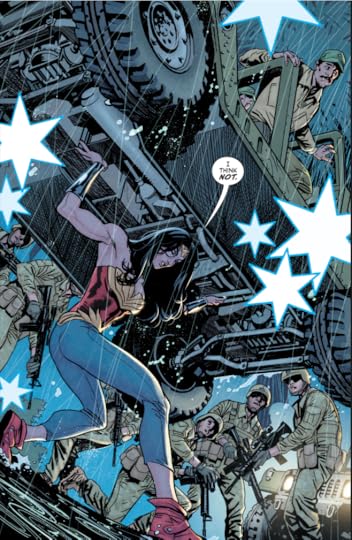
The structure of the story and the lack of violence are essential because they reflect the main character. Instead of trying to force the ultimate female hero through the prism of the male adventure story, we get something that is true to Wonder Woman, true to the environment that created her.
That male lens would also dictate that this story be filled with scantily clad supermodels in suggestive poses with other scantily clad supermodels. And it’s not unreasonable to expect at least some level of cheesecake given that Paquette draws attractive women. I think part of this reputation comes from his work on a books like Codename: Knockout, but that book featured both cheese and beef cake, and was specifically created to feature titilating poses of men and women. The ability to draw attractive people shouldn’t be an issue here, really, so much as whether or not they’re being drawn in way that seems unnatural for the sake of appeasing the male gaze.
But Paquette avoids that. Yes, his Amazons are beautiful, but they’re also Amazons: it’s part of the initial concept, that they’re subjectively perfect in every way. But at no point are they placed into positions or drawn from angles that would serve to exploit their attractiveness. There are no typical comic book panels of just the posterior and no one wears a skirt that happens to be a bit too short. Yes, Diana’s anatomical proportions seem to defy nature, but she and the Amazons wear clothes you would expect a group of active, trained warriors to wear. Their outfits aren’t just practical, they’re clearly informed by their Greco-Roman roots.
Paquette embraces those roots. He incorporates that cultural aesthetic into all aspects of the Amazons, going so far as to intersperse the initial scene with the types of images you’d find on the walls or on pottery in ancient Greece. The suggestion here is that the Amazons are, from the very start, immortalized in Greco-Roman history, something that would come up again later in this book.
Paquette also makes every single character in this book look unique. It’s a stunning accomplishment, really, if you just consider the overwhelming number of Amazons he has to draw. But all of them, from their faces to their hair to their attire, are distinct from each other. I can’t even fathom the amount of time that had to have been spent on even background characters in order to pull this off; it’s unbelievable. It makes Themyscira seem like a place where everyone is free to express herself however she may choose. It emphasizes the fact that this culture is far more advanced than our own.
For all the credit that Morrison is going to get for this book, it’s just as much Paquette’s. This is career elevating work for him; it might be for Morrison, too, if that’s possible.
If Morrison owes much of the success of this story to Paquette, then Paquette owes much of the success of the art to colorist Nathan Fairbairn.
There’s a very clear, very obvious trap lurking in WW: Earth One with regards to the colors: the book is split between two worlds, that of the utopia of Themyscira and that of our modern day real world. This is a trap because it would be very easy for any colorist to simply portray the former in bright, positive colors and the latter in dark, dreary colors. But Fairbairn has made a career on telling stories with his colors. Neither world is as simple as being all light and all dark. There are degrees at work, degrees which make these worlds fully realized, even beyond the words and the line art.
While Themyscira contains darkness, there’s a subtle difference. The colors are softer and more distinct; even the hunt that takes place at night has a playfulness and calmness that underscores the Amazonian society. This is a place where everyone is treated fairly, a virtual utopia, where the night is dark, but not scary. The colors during the day are bold and bright, but complimentary, both creating a sense of individual freedom while embracing unity. There’s a thematic cohesion to Paquette’s designs and Fairbairn takes that to the next level with his colors.
On the other hand, our modern day world isn’t just starkly dark and depressing. Yes, it’s not as bright as the world of the Amazons, but this isn’t the Sin City movie, for example. Man’s world has variation, but unified by a roughness, as if it hasn’t completely fallen into darkness. And that, of course, is the point: man’s world can be saved, it just needs someone to save it. And while Wonder Woman is painted in relatively muted tones when she initially arrives, when she returns at the end of the book she is as bright and bold as we would expect. She’s here to save the day.
That isn’t to say that WW:E1 is perfect. There are two problems in particular that, to their credit, stem from an overreach on the part of Morrison and Paquette.
The first is Steve Trevor. While changing his ethnicity raised many eyebrows, there’s a very clear reason for it within the story. Wonder Woman goes to America and finds a country that has marginalized all but the straight, white men. To prevent Trevor from being a part of the very institution that WW would be facing off against, he could no longer be white. His gender and orientation are somewhat essential to is role (as he is a man setting foot on Themyscira and he is attracted to Wonder Woman), but his race makes no difference. This new iteration changes that and to good effect.
The problem, then, is in making Trevor African American. The only goal is to make him something other than white. The choice to make him black is loaded with problems, if only due to the imagery involved. On Themyscira, submission to another is considered a form of trust, of love, but to ask the sole black character in this book to wear bondage gear seems tone deaf. I wouldn’t go so far as to call it offensive, but the idea is never really addressed or fleshed out, so we simply have Diana trying to convince Steve to wear clothing meant to evoke images of slavery. On one hand it speaks to Diana’s ignorance of this new world and Steve’s place in it, but that’s as far as it goes. And given that Steve could be any ethnicity other than white for his new role to work, it’s hard to understand why Morrison decided he should be black.
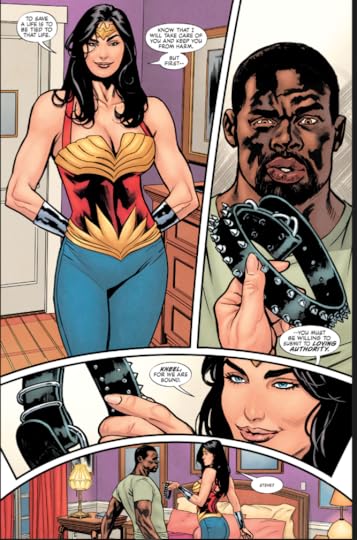
At the very least, it kicks you out of the narrative, just like the introduction of Etta.
Etta is, compared to every other female in this book, overweight. And while her introduction to the story is when she gives her testimony at the trial of Wonder Woman, chronologically her first appearance comes on a bus ride with her sorority sisters to South Beach for spring break. It comes with one of her sisters suggesting that she ate the food they had gathered to feed the less fortunate. In other words, it feels like she’s being body shamed.
Fortunately, Morrison quickly undercuts this. Etta isn’t fat, not in her eyes, and those are the eyes that matter. In fact, she isn’t shy about how perfect she thinks her appearance is; she is full of self-confidence, even when one of her sorority sisters is insulting her. It doesn’t matter to her. Etta is above it. She knows herself and she’s happy with who she is. This initial introduction wasn’t an indictment on her, but on the other women, on how they treat those who don’t conform to society’s ridiculous notions of beauty.
Even Wonder Woman herself gets in on the act: “Oh, what has man’s world done to your bodies…” But in the panel before that we don’t just see Etta, we see the typical comic book (typical magazine) female form: beyond petite and not at all healthy. Wonder Woman isn’t commenting on Etta alone, but all of the sorority girls.
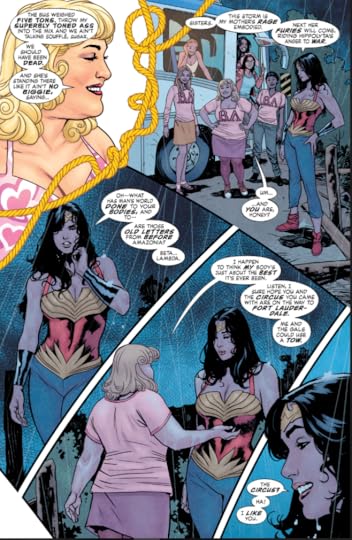
But commenting on female beauty standards is going to be a tricky situation even when not written and drawn by men. There’s just too much to unpack to adequately address in a entire graphic novel, let alone a few pages. The fact that Morrison and Paquette don’t shy away from the issue is commendable, but they were never going to really be able to do it justice. On the other hand, ignoring the issue would have been equally as problematic, so they were painted into a bit of a corner no matter what. This is the price you pay for deciding to tell a story about the most recognizable female super hero in the world.
Ultimately, though, Wonder Woman: Earth One is an ambitious retelling of the origin of one of the world’s greatest superheroes. It succeeds far more than it fails, and even when it does falter, you can appreciate the attempt. I appreciate the fact that Morrison and Paquette took chances on this book and it’s clear from the work that those chance energized them.
Let’s hope we get a second volume so they can do more.
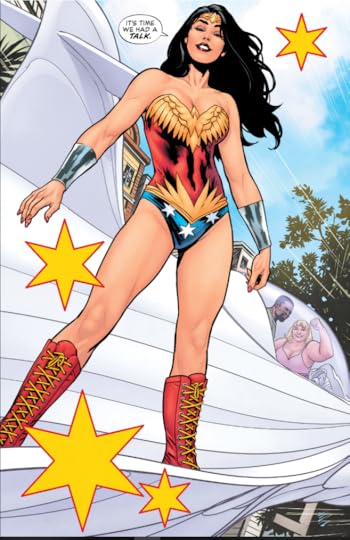
October 19, 2023
Parents: Use your phone as much as you want
As much as it pains me to use the current hip vernacular, I’m going to: parent shaming.
At one point, I think the focus for parent shaming was screen time, as in how much time your child can spend staring at a screen of some kind. But there’s a lot of grey area in the studies on the impact screens have on children. The general consensus is that too much screen time is bad, yes, but different types of screens have different impact. What’s on said screen is also a consideration.
So screens are not as cut and dry as other parent shaming options.
Diet? Sugar is the heroin of toddlers, after all.
Education? The best time to learn a second (or third!) language is at the age of two, you know.
Culture? Listening to an opera would be so much more stimulating than listening to the Cars soundtrack (again).
But, no, those options are somewhat narrowly targeted and, for many parents, easily avoidable. What, then? What is something that every parent does that can be ridiculed by those who wish to feel superior?
Cell phones.
Boom.
You use your cell phone when your child is with you? That is shocking — shocking, I say! Your child is going to think you care more about your cell phone than you do about your own precious little angel!
It is impressive how many parents take to the internet to rail away against the evils of using your cell phone when your child is present, pretending as if they’re doing it to somehow help other parents. I can’t imagine a single parent reads these articles and suddenly changes their ways. No, they’re written so the writer can feel superior.
I know full well how tempting it is to use a device as a baby sitter. I also know that there are other toys which can do roughly the same thing while allowing your child to control the creativity. That said, I don’t begrudge anyone who’s in a position where a device is their best option. I know too many single parents to think that a tablet can’t be a life saver.
But let’s get back to parents using cell phones.
I understand the basic concept behind the complaint, the idea that kids will think that they are less deserving of your attention because you are looking at your phone all the time. But consider that thought. Think about how much the average parent has to do with their child over the course of any given day. It would be physically impossible to spend more time on your device than interacting with your child. They are tiny tyrants who need you to survive. A cell phone isn’t going to dress them or take them to school or get them to bed. A cell phone isn’t going to comfort them when they get hurt or help them through some strong emotions. We have few moments that aren’t controlled by these kids and very, very few of those moments can be solved by cell phones.
So if your kid is playing and you decide to check Facebook, where, exactly, is the harm? If your child needs you, you’re there. But your child doesn’t always need you and, honestly, it’s probably good for them to realize that. “Hey, child of mine, you’re doing fine on your own and I trust that you can scoop sand into a bucket without me watching you like a hawk, so you do your thing, I’ll be right over here if you need me.”
The crazy thing about it is that if there’s another parent shaming method out there, it’s the “helicopter parent” who is always hovering around their child, never letting the kid do things on their own.
So if it’s bad for us to follow our kids around and obsess over them and it’s bad for us to do other things while we’re with our kids, then what, exactly, are we supposed to do?
I am overly sensitive about my son knowing how much he means to me. I tell him constantly. It’s a whole thing. So at some point early on in his life I decided that if I’m going to use my smart phone around him, I’m going to tell him why I’m doing it. I want him to understand why looking at this tiny screen would be something I would want to do while he’s eating dinner or or watching cartoons.
So I say things like “let’s see if mama has left work yet” or “let’s see what the weather is going to be like” or “grandma sent me a message.” I try to explain what social media is, but he does’t seem to care. In fact, he doesn’t really care about any of that, but I feel like telling him what I’m doing at least helps him realize that there’s a purpose, that I’m not just looking at my phone for no reason.
I explained this to a therapist who works with children and she told me it was genius, so I’m running with it.
Here’s the thing: being a parent is hard. I realize that’s like complaining that your diamond shoes are too tight, but it is what it is. And sometimes you can only take so much Paw Patrol or so much doing funny voices before you need a break, and in today’s day and age, a break is looking at your phone. And I don’t think there’s anything wrong with that.
So for those who are thinking about telling other parents they need to stop using their phones so much around their children: don’t. Get off your high horse and just let a fellow parent be. We are all stumbling through this together and the last thing any of us needs is someone giving us shit for looking at Facebook while our kid is crashing cars into each other.
Go to town, parents. Use your phones as much as you want. I don’t have the answers for that and I’m not stupid enough to think that I do.
The post Parents: Use your phone as much as you want appeared first on KyleGarret.com.
October 18, 2023
Discovering Hip Hop at 40
Having kids leads to some strange changes in your life.
Like listening to hip hop.
I was born in the mid-70s, so suggesting that I’m a child of the 80s wouldn’t be far off. But puberty wrecked havoc on me, to the point that I became almost a different person. At the very least, I went from a kid who generally did what he was told to a kid who generally tried to do his own thing. By this token, the 80s weren’t so much my decade as the 90s, after puberty, after I’d decided to start making decisions for myself.
Rap music “broke” in the 90s, really. It had been bubbling below the surface of mainstream music for years, but it really broke through in the 90s. That’s when it became popular music. And even now, I have some affection for 90s hip hop.
But that wasn’t me. I was an angry white kid from the suburbs who had no idea why he was angry and seemingly out of no where came an entire genre of music that spoke to me: grunge. And when grunge burned away, I’d already jumped ship to its main influence, punk rock. And punk rock led me to indie rock, which more or less allowed me to mix some sadness in with my anger.
I stayed away from hip hop. I needed music that spoke to me, but I was also for anti everything, which meant that listening to popular music was out of the question. And, like I said, rap had taken over the Top 40.
I dabbled in hip hop over the years. At a certain point, indie rock began embracing lesser known rap acts, I suppose the way that Anthrax embraced Public Enemy. And I liked hip hop. I’ve just never had any idea where to begin with it and, really, no motivation to do so. I was waist deep in minor chords and feelings and adding another style of music to the mix was just too much for me.
But when you have kids, you suddenly find motivation for things, motivation that wasn’t there before.
I started listening to hip hop regularly after our son was born. The internet is great for getting suggestions; there are a hundred streaming music services that will take one song you like and turn it into an entire playlist. So slowly but surely, I waded deeper and deeper into the hip hop waters.
I’m still a novice, I fully admit that, and I doubt anyone would ever accuse me of being anything other than a dabbler. But I’m open to anything. I want to learn.
What does this have to do with my son?
I wasn’t raised on music. My parents loved Abba and Neil Diamond, but beyond that they seldom even talked about music. When I discovered the Beatles, I raided my parents record collection, but I’d never heard of them from my parents and was surprised to find those albums in the house.
I want my son to be exposed to as much as possible. I know that hip hop might seem like a small thing, but I feel like it’s important. I feel like growing up around a diversity of music is important.
It’s more than that. We live in the Bay area and his class at school is fairly diverse. But I know how much more impact parents can have on kids and I don’t want him to see me living on a steady diet of sameness. I want him to experience a wider world that I only ever got glimpses of and I at least want him to feel like that experience is encouraged, not just overtly.
Honestly, it’s been a lot of fun to dig into a new genre of music, particularly something that’s so far removed from what I’ve listened to for most of my life. It’s like learning a new language. I’m starting to become discerning, starting to notice what I like about particularly songs and what I don’t. I can’t really verbalize it yet, but I’ll get there.
And I still can’t dance, but my son doesn’t care.
The post Discovering Hip Hop at 40 appeared first on KyleGarret.com.
October 17, 2023
What I said when my son asked me what make-up was
When our older son was 3, he asked me what make-up was.
I stopped myself.
I almost answered with the first thing that came into my head, but made a change before anything came out of my mouth. That change was not using the word “women.”
I’m assuming he heard the term “make-up” from my wife, probably that morning as she was getting ready for work, which meant he had to ask me about it on the way to school. So, of course, my wife was on my mind when I started to answer. But I managed to modify my answer before it came out of my mouth.
“Make-up is something people put on their face to make it look different,” was my answer, or at least as close to it as I can remember.
“Do you remember that clip we saw of the boy whose face was made to look like Rubble? That was make-up.”
Rubble is a member of the Paw Patrol and the clip was on the Nick, Jr. app. It was a short video of a make-up artist painting the boy to look like Rubble, a dog.
It’s a legitimate question to ask why I stopped myself. At the time, it was because I don’t want my son to grow up assuming that only women can wear make-up. I don’t honestly know any men that wear make-up, but I know they exist and I don’t want my son thinking of them any differently.
But afterwards, I realized that I was more concerned about the idea of teaching him that women wear make-up. Yes, women can wear make-up, just like men can wear make-up, but they don’t HAVE to. I mean, socially speaking they do which is a problem, but I want him to know that it’s not something he should assume.
I realize, of course, that his 3 year old brain will probably not hold on to my explanation. And, really, my answer was less for him than for me. It forced me to think about the answer.
I’m trying my hardest not to instill in him the same assumptions that were introduced to me growing up. To say that my father was opinionated would be an understatement, but I know I have that within me, too. I have very strong opinions and I’m not shy about sharing them. But I don’t want to put any of that on my son. I want him to walk into the world with as few preconceived notions as possible.
I’m left wondering how often such issues are going to come up (frequently) and how well I’m going to deal with them. I caught myself this time, but what if I don’t the next?
Which is, I think, why it’s important that I did catch myself this time, even though my son is only three. This is practice. This is preparation for the coming years when he takes my comments to heart, when my opinions start to influence his way of thinking.
I think the fact that I’m thinking about any of this at all is a good sign.
The post What I said when my son asked me what make-up was appeared first on KyleGarret.com.
October 16, 2023
Micro-inclusiveness: Raising a white boy
I wrote this five years ago. Since then, we’ve had another son, and his experiences have been very similar.
My son is four. He is as white as they come.
His current cartoon fixation is Handy Manny. He’s watched roughly 8 episodes and so far we’ve mostly talked about the fact that Manny and his friends can speak two languages and I try to translate for him in a more deliberate way than they do on the show. Fortunately for both of us, my Spanish covers everything Manny and his friends say.
My son thinks it’s cool that they speak two languages and has said he’d like to learn Spanish. But, you know, he’s four, so we’ll see how that goes.
It helps that he goes to a diverse school. His former best friend was from France and spoke both French and English. He moved away a few months ago and one of his other friends has now stepped into the “best friend” position. He’s Chinese American and speaks English and Mandarin. For my son, speaking two languages isn’t unusual.
He has two other friends that he plays with every day at school. One is a Chinese-American girl, the other an Iranian-American boy. There were probably a half dozen different languages being spoken at the latter’s last birthday party.
This afternoon my son diverged from his Handy Manny fixation and asked to watch something else: Doc McStuffins.
You don’t need me to go on and on about Doc McStuffins. Here’s a decent overview, although even the accolades list doesn’t do it justice. You can check out what Common Sense Media has to say, too, as they are usually pretty good about these things. Neither of those links really drives home how important Doc McStuffins is and how essential it has become.
More to the point, Doc is a black girl, just as Manny is a hispanic man. They are the main characters on their shows. They are not sidekicks, they are not punching bags. They are kind, nice, genuine problem solvers who happen to not be white.
I know that none of this is huge. I know that I can’t suddenly claim that my son will treat every one equally when he’s an adult because I don’t have a crystal ball. I can’t specifically tell you what kind of impact these shows are having on him, or even the impact of the fact that he has friends who aren’t all just like him. I don’t know how any of this works.
But I know that I grew up surrounded by white people, watching cartoons about white people, and while I don’t think I am ever consciously prejudiced, I have no doubt that I am guilty of microagressions that I’m not even aware of. I also know that I spent most of my life being completely clueless about anyone who didn’t look like me and even though that’s changed over the last decade or so, I still feel like I missed out on a lot before that.
I think this is how it starts, though. I think watching cartoons with diverse characters is how it starts. Going to a school with diverse students is a start. Being raised by parents who are aware of how important this is is a start.
I think the goal of every parent is for their child to grow up to be better than they were.
In that case, this is definitely a good start.
The key is making sure that continues.
The post Micro-inclusiveness: Raising a white boy appeared first on KyleGarret.com.
October 10, 2023
Squadron Supreme is better than Watchmen
It was a groundbreaking superhero story. It took archetypal characters to their organic extremes. Every action had consequences. Change was real and long lasting. These were sophisticated stories featuring complex moral and philosophical issues, told through the genre of brightly colored super beings.
It wasn’t Watchmen.
The comic in question was The Squadron Supreme, a 12 issue limited series written by Mark Gruenwald with pencils by Bob Hall, John Buscema, and Paul Ryan, and inks by an all star cast. It debuted in September of 1985, a full year before Watchmen. There are a lot people (including me), who consider it an unsung classic, deserving of the type of recognition that Watchmen gets. So why is it overlooked?
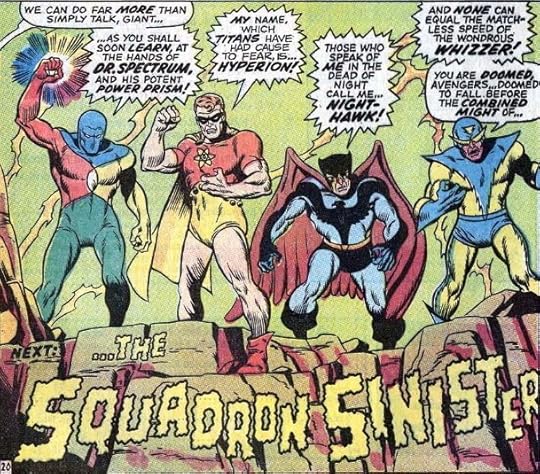 A Brief History of the Squadron Supreme
A Brief History of the Squadron SupremeThe Squadron Supreme were created by Roy Thomas and John Buscema, although it would be fair to say they were actually created by Thomas and John’s brother, Sal. See, the Squadron first appeared in Avengers #85 in 1971 as good versions of a team that Thomas and Sal had introduced just two years earlier in Avengers #69: the Squadron Sinister. Each team had the same four members (although the Supreme version had an additional four), but they weren’t the same. One was bad, one was good.
If you’re confused by that, you’re not alone. Even Marvel’s own production office couldn’t keep the two teams straight, advertising the “Squadron Sinister” on the covers of two issues of the Avengers that actually featured the Squadron Supreme.
Anyway, both teams were created as analogs for DC’s Justice League of America. The common members of the two Squadrons were Hyperion (Superman), Nighthawk (Batman), Whizzer (the Flash), and Doctor Spectrum (Green Lantern). When the Squadron Supreme first appeared, their line-up also included Lady Lark (Black Canary), a different character named Hawkeye who would later go by Golden Archer (Green Arrow), Tom Thumb (the Atom) and Cap’N Hawk (Hawkman). It’s kind of interesting that those were the additions, as opposed to versions of the remaining Justice League founders (Wonder Woman, Aquaman, and Martian Manhunter).
The Squadron Supreme would make a few more appearances in the Avengers, as well as showing up in an issue of Thor and Spider-man. But their big story line would come with an extended arc in the Defenders. The ranks of the team would fill out here as well, with the additions of Power Princess (Wonder Woman), Amphibian (Aquaman), Arcana (Zatanna), and Nuke (Firestorm). Missing from the ranks is the Skrullian Skymaster (the Martian Manhunter) who would be briefly shown as a founding member in the first issue of the Squadron Supreme series, but would only be revealed in the Squadron’s entry in the Marvel Handbook (at least until the follow-up to the follow-up of the Squadron’s series).
Now, a word about Nighthawk. Nighthawk is Kyle Richmond. On our world (the 616 Earth of the Marvel U), he was a Defender. But here’s the thing: the Defender known as Nighthawk wasn’t actually of our world! He was, in fact, the Nighthawk from the Squadron Sinister who switched sides and ended up joining the Defenders!
I know, right?
But it’s the Squadron SUPREME’s Nighthawk that is important. In the Squadron’s next appearance, Kyle Richmond had become president of the United States of the Squadron’s world. He was soon taken over by the Overmind, who used Richmond to turn the U.S. into a paranoid police state. The Overmind himself was under the influence of Null the Living Darkness, but that’s neither here nor there. The important bit is that the Overmind also took over the Squadron. The Defenders managed to free the Squadron and together they defeated Null.
And that was it.
Because No One Demanded ItIn the sixteen years since the Squadron Sinister first appeared, the Squadron Supreme had only made a handful of appearances in the Marvel U, none of which had any lasting impact. It’s hard to imagine there was much of a fan movement to get them their own series.
There also wasn’t much from the Defenders story that would suggest a Squadron Supreme story needed to be told. They’d been taken over by a supervillain, but what superhero hasn’t? But if there was a core idea behind the Squadron’s series, it was to extrapolate the bigger picture from something small. Gruenwald took the germ of the Defenders story and turned it into a virus. The Squadron had been controlled by the Overmind for quite some time, and they’d been busy. They’d helped to build the United States into a fascist country that then spread across the globe by invading and occupying the rest of the world.
But then the Overmind went away and oppressive order turned into complete chaos. The world hadn’t actually ended, but the Squadron Supreme’s earth was about as post-apocalyptic as you could get.
With the world in shambles, the Squadron Supreme decided to get proactive.
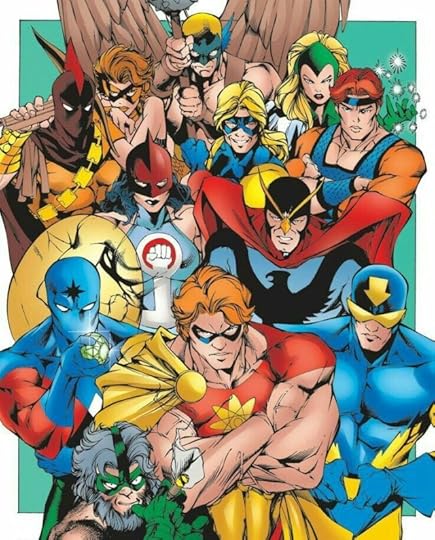
But this isn’t The Authority style proactive. No, the Squadron decides to set themselves up as a super power. Federal governments remain, but in reality everyone answers to the Squadron. The Utopia Project initially focuses on feeding the world, building homes, bolstering the economy, and dismantling the military. After all, what good are stealth bombers or even nuclear bombs when you’ve got Hyperion, the stand in for Superman running around?
In a world full of superheroes, there are always supervillains, they always seem to escape from whatever prison they’re locked in. So to break this endless cycle, the Squadron Supreme come up with the Behavior Modification Process. Basically, it’s a machine that changes a person’s mind, removing their criminal impulses and replacing them with a desire to do good. Before Zatanna, Dr. Strange, and Nick Fury began mind wiping, the Squadron Supreme was altering people’s brains.
And then they got rid of death, or at least created world wide system to put people into deep freeze until they could be cured or brought back.
Not every member of the Squadron is on board with their program, though. Nighthawk leaves the team from the start, determined to find a way to stop is former compatriots from ostensibly taking over the world, even if they have the best intentions. He argues that they should be helping humanity, not commanding it.
The series ultimately follows two narratives: The Squadron’s efforts to create a Utopia and Nighthawk’s plans to oppose them. The two story lines come to a head in the finale which was, at the time, one of the most brutal comics I’d ever read.
Name a political issue and there’s a reasonable chance the Squadron Supreme limited series dealt with it. And each issue featured actual change, be it a new development in the Squadron’s plans, the death of a character, or the escalation of a moral dilemma. This was a big time ideological battle taking place in the pages of a superhero comic. It may have lacked the subtlety of a certain other 80s comic that rewrote the rules of superheroes, but it was just as deep.
I’m not doing the series justice, in large part because this lacks context. Superhero stories like this just didn’t exist back in 1985, even though they would become all the rage after Watchmen was released. But the Squadron Supreme series came first, yet isn’t showing up on a Time magazine list any time soon.
The Watchmen FactorThe thematic similarities between the two series are striking.
Both books feature superheroes taken to their extreme ends. In the case of Watchmen, it’s breaking them down to the fragile human beings that they really are. As many of said, it’s a deconstruction of not just the characters, but the genre. If anything, Squadron Supreme is pumping the characters full of steroids, taking the idea of superheroes to the other end of the spectrum, where they place themselves above the rest of the world. In Watchmen, they are down in the gutters with the rest of us, manipulating events in the background. In Squadron Supreme, they are overt, taking over the country and forcing their will upon us.
These behaviors carry over to the way the story is told. Both comics feature secret plots to prevent horrible events from happening, but in Watchmen those plans are kept secret from both the characters and the reader; we only as much as they do. In Squadron Supreme, we see it all. Nothing is hidden. And why would it be? It’s the actions that are important, so we need to see them, as opposed to Watchmen where the driving force is the mystery. If we had all the information in Watchmen, it would lose momentum.
Even these secret plans are set opposite each other. Ozymandias’ goal is to prevent the world from falling into chaos brought by a third World War, a nuclear World War. Nighthawk’s goal is to prevent the world from becoming imprisoned by the extreme order brought by the Squadron Supreme. The beginnings are the same way. When Watchmen opens, there’s a certain status quo, one that involves all (but one) vigilante having retired and Richard Nixon serving yet another term as president. The death of Comedian up ends all of that, introduces chaos into the equation, chaos that eventually pushes the world to the brink of WWIII. In Squadron Supreme, the world has already fallen into chaos, but the Squadron Supreme decides to create order.
It’s also interesting to note that both books deal with analogs of other characters. Moore wanted to use the Charlton superheroes, but was famously told to create new characters instead. Moore wanted to use recognizable characters so that the opening had some emotional resonance. DC obviously didn’t want to ruin their newly acquired IPs. It was an odd decision, though, given that Watchmen doesn’t take place in the mainstream DCU, or even on an alternate Earth, as by this point DC had done away with such things. Captain Atom, Blue Beetle, et al. would have been perfectly fine in the DCU even if Moore had used them.
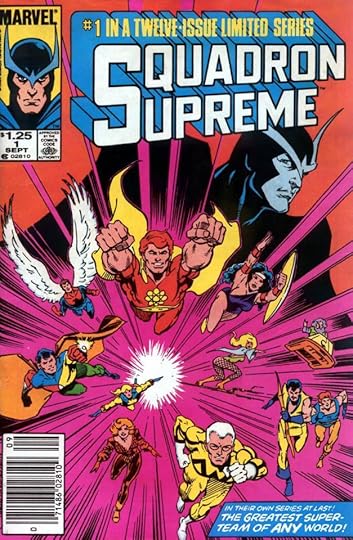
The fact that Watchmen took place in its own reality, set aside from the DCU, at a time when DC had gotten rid of alternate realities, increased the profile of the book. This must be something special if DC were willing to create a superhero book that was completely removed from the rest of their line.
By that same token, Squadron Supreme was firmly entrenched in the mainstream Marvel U, even if the series took place on an alternate Earth. It had roots in the Avengers. It was seen as just another Marvel comic.
Opposite Ends of the (Doctor) SpecturmUltimately, the Squadron Supreme and Watchmen are as different at the two men who wrote them, Mark Gruenwald and Alan Moore.
By the time Squadron Supreme debuted, Mark Gruenwald had been working for Marvel for 7 years. He was initially hired as an assistant editor and had moved up the ranks quickly. He was perhaps best known as the editor of the Avengers line of comics, although he would later become synonymous with Captain America, a title he wrote for 10 years. Gruenwald’s run on Cap would feature incredible highs (everything leading up to #350, really) and incredible lows (the newly returned Captain America armor, for example), but the length and depth of his time on the book would ultimately make him one of Captain America’s premiere creators.
Gruenwald wrote superhero stories. He edited superhero stories. He was known as the guy who knew every piece of obscure continuity in the Marvel universe.
Leading up to Watchmen, Alan Moore had made a name for himself in the U.S. with his impressive run on Swamp Thing. He’d also penned the classic Superman stories “For the Man Who Has Everything” and “What Ever Happened to the Man of Tomorrow?” but the bulk of his work had been on a sophisticated horror title that had parted ways with the Comics Code Authority and would eventually be labeled “Suggested For Mature Readers.”
To say that Moore was coming at Watchmen from a different direction than Gruenwald was approaching Squadron Supreme is an understatement.
The two publishers were in very different places as well. Marvel was being run by Jim Shooter, who had hammered the company into a well oiled machine of family friendly superhero fare. Marvel wasn’t in the habit of taking risks at this point in its history. The fact that the Squadron Supreme even happened was impressive, but the fact that it took place in an alternate reality made that possible.
DC, on the other hand, was being run by Jenette Kahn, who had already broken new ground with Frank Miller’s Ronin and the Dark Knight Returns, not to mention the new direction Moore had taken Swamp Thing. Post-Crisis on Infinite Earths, DC seemed focused on publishing a variety of content that appealed to a wide range of ages.
So when DC, hot on the heels of The Dark Knight Returns, announces that the guy who rejuvenated Swamp Thing would be releasing a brand new limited series that was meant for mature readers, people take notice. The same could not be said for the guy who writes Captain America releasing a new series starring minor characters from an old Avengers story line.
Squadron Supreme is pure superhero story and embraces those elements; everyone runs around in spandex and capes like it’s perfectly natural. There are big, bombastic battles. No one will ever think this is anything other than a superhero comic, even if it’s a truly phenomenal one.
Watchmen simply has some superhero dressing. It’s not the story of supremely powerful beings living among us. It’s the story of regular humans doing insane things for a variety of reasons. It’s just as much a murder mystery and political thriller as it is a superhero story. It’s science fiction. Watchmen stands out from the metric ton of superhero comics being published by the Big Two every month.
Watchmen made its characters less super; Squadron Supreme made them more. They appear to be diametrically opposed, yet did so much to change the way superhero stories are told.
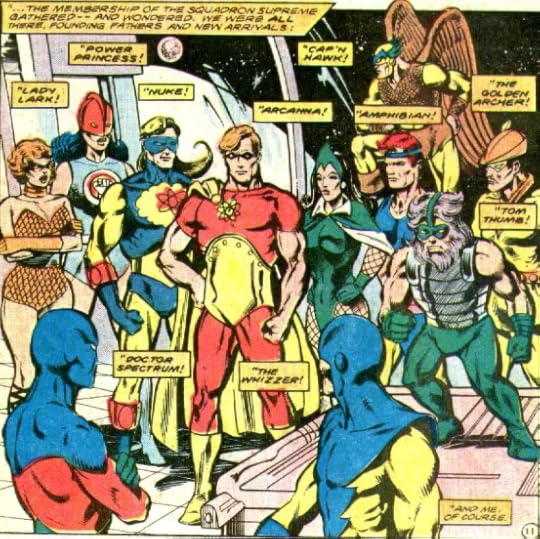 The Post-Gruenwald Era
The Post-Gruenwald EraAfter the Squadron Supreme limited series, Gruenwald and artists Paul Ryan and Al Williamson abused the Squadron some more with the “Death of Universe” OGN. This particular adventure took place in space, and somehow on their return trip, the Squadron ended up in the mainstream Marvel U. They kicked around for a bit before the Avengers finally sent them home. Sadly, they returned to a very 90s universe in “New World Order.” They would eventually appear again in the Exiles series.
There was also an attempt at creating another version of the team, spear headed by J. Michael Straczynski. The goal, it seemed, was to make them more realistic. It didn’t turn out too well.
The team’s highest profile member is Hyperion, would play a major role in Jonathan Hickman’s Avengers run, although Hickman has stated that this is yet another version of Hyperion and not the “Gruenwald version,” as he called it. That’s unfortunate, as this Hyperion is the only survivor of a destroyed Earth, and there’s a part of me that would like to see the Squadron’s earth wrapped up for fear of anyone doing any more harm to the team.
But the original Hyperion did eventually pop up, part of the fall out from Secret Wars. A new team is formed consisting of characters who have lost their alternate realities. The concept in and of itself is fine, but the series was uninspired and ended after less than two years.
The Squadron Supreme had their moment to shine in a complex, epic limited series. If you love superheroes, you owe it to yourself to track down this truly groundbreaking run.
The post Squadron Supreme is better than Watchmen appeared first on KyleGarret.com.
October 2, 2023
Daycare is killing me.
I wrote this 9 years ago when our first son had begun going to daycare.
When I first started writing about him online, I called him Appleseed. We’d spent months reading those “at this month of your pregnancy your baby is the size of a” articles and for some reason him being the size of an apple seed had stuck with us.
He smells different.
At the end of the day, Appleseed smells like the daycare. It’s similar to how an airplane or a hotel room smells, that attempt to make something sanitized that will never ever be sanitized. I smell it when I kiss his head. He doesn’t smell like us.
I don’t think Nicole has noticed because I’ve done a good job of re-scenting him before she gets home. I sit on the couch with him and give him Sophie the Giraffe, which he promptly sticks in his mouth and gums like crazy. He slobbers everywhere. I kiss his cheeks, his head, the spot where his neck and his head connect which makes him squeal with happiness.
The squeal is muted. There’s less energy to it. His smiles don’t come as quickly. His giggles are harder to come by. And he smells different.
There’s a logical explanation for it. Besides the sensory overload, Appleseed doesn’t sleep at daycare, not like he should. They can rock him to sleep, but he wakes up when they try to put him in the crib. So when I pick him up, he’s tired, too tired to humor his father. After I’ve gotten my fill of drowning him with affection, I decide to rock him to sleep. It doesn’t take long.
The best way to make sure Appleseed will not just sleep, but sleep for a long period of time, is to sleep with him. So I take him into our bedroom, lie him on the bed, crawl in next to him, and tip him over on to his side. He likes to sleep on his side, he just can’t maintain it on his own. We’ll spend the next two hours or so like this.
It’s during this time that the smell fades. Cuddled up in bed, cuddled up next to daddy, he begins to smell like us again.
After the long nap, he starts to perk up. His energy returns. And mommy comes home. The smiles come fast and furious. The giggles and squeals are back. Appleseed has returned.
I know that he’s fine at daycare but that doesn’t mean I like it. That doesn’t mean I don’t feel like simultaneously throwing up and crying when I drop him off, and that’s after I make it out the door. Up until

that point, I feel like taking him back home and skipping work.
He’s in the infant room at his daycare, and the teacher to student ratio maxes out at 4-1, although it’s probably more reasonable to say 3-1, as one of them is almost always asleep. But between diapers, bottles, and tantrums, how much attention can those three really get?
When I drop Appleseed off in the morning, I put him in a boppy and I find him a couple of toys. That’s how I leave him and it has, so far, been how I’ve found him when I come back. It’s a different boppy and they are different toys, but that’s where he is, because he’s a relaxed baby who can hang out like that.
And that’s perfectly fine. I know he screams his head off when they change him or when they put him in a crib. I know he’s happier on the boppy and he’s certainly more quiet.
When I show up, he smiles, he squeals, and he kicks his arms and legs around, so I know he’s happy to see me. I know he’s still him. I know he’s fine.
But I want him to be more than that.
Staying at home with Appleseed was exhausting, and I only had to do it three days a week. It took so much energy to stay engaged with him and I’ll admit that I took a fair number of breaks. When four o’clock rolled around, it was time to watch a little bit of baseball. He’d zone out on it for a few minutes, but then get bored. But those few minutes were nice.
But I did my best, as I know Nicole did. She felt even more pressure than me, I think, to interact with Appleseed every minute he was awake. A lot of that is because of how much stuff she reads on the internet.
Our son his happy and energetic to the point where I’m a bit confused by it. I don’t think we do anything special. We just love the heck out of him to an obnoxious degree. And, apparently, he responds to that.
Going to daycare means he’s no longer getting that as much as he used to, and that makes me sad.
It’s hard for me to think about Appleseed when he’s at daycare because it breaks my heart. I sometimes have to force myself not to think about him because it’s honestly too much. And I resent the fact that I have to stop myself from thinking about my son.
For the first three weeks of daycare, Appleseed will only be there 3 days a week. After that, he’ll be full time, Monday through Friday, 8:30 AM to 6:00 PM, although as the guy who picks him up, I can guarantee you he’ll never stay that late. I’ll be skipping out of work early a lot more often.
I can’t imagine what it will be like when he’s there every weekday. It seems unbearable.
So the wheels are turning. Maybe we can handle three days a week and maybe that’s all we need to handle. I just need to find a way to only work three days during the week.
Because I don’t want him to be “fine.” I don’t want him to get the bare minimum of attention. I want him to have all the things he’s had for the last 5 months.
He deserves all that and more.
The post Daycare is killing me. appeared first on KyleGarret.com.
September 29, 2023
The Ewingverse Avengers, Part 3: Ultimates
We saw in New Avengers where White Tiger and Power Man ended up after Mighty Avengers, but what about the rest of the team? Well, Blue Marvel and Spectrum join the Ultimates, the first version of this team to exist in the mainstream Marvel U.
They are joined by Captain Marvel, Black Panther, and Miss America.

They are meant to be a team that solves the big problems, that are proactive, that tackle the problems that require the smartest, best thinkers and those with experience dealing with crazy.
It’s a fantastic line-up and one that stays more or less intact throughout this run and the one that follows. I would have loved to have seen occasional guest star the new Giant Man join in some capacity and it seems like Ewing was headed in that direction, but we never get there.

The book is firmly rooted in the cosmic side of the Marvel U, which is really the final step in Ewing’s story. We’ve now gone from the community rooted Mighty Avengers to the global superheroes of the New/U.S. Avengers, and now to the universe spanning (and beyond) adventures of the Ultimates. It’s a great evolution and showcases Ewing’s abilities to write at any level.
The Ultimates are put together by Captain Marvel to fix big problems and they start off with one of the biggest: Galactus. Ewing’s take on Galactus is great. He fleshes out his origin, gives his existence context within the greater Marvel cosmic universe, and then does the unthinkable: makes him a force for good.
The ideas and adventures in the Ultimates stand side by side with some of the best 70s Marvel stories, which is probably the biggest compliment I could give the series.
The first six issue comprise an epic story centered around Galactus, but that spans well past him. We also learn very quickly that with all these long standing Marvel heavy hitters, Miss America is perhaps the most important.
The back half of this twelve issue series features an apparent inevitability for Ewing: a crossover. However, this could be the finest work Ewing has done incorporating an event into one of his books. Captain Marvel plays a pivotal role in Civil War II and Ewing takes full advantage of that, doing a better job with her character than the main series does.

It’s easy to see how the team would fall apart during Civil War II. Captain Marvel wants to be proactive to the point of arresting people before they commit crimes. That’s not something Black Panther would ever be able to stand for. The division doesn’t even split the team in half so much as put everyone at odds with Captain Marvel.
The first series ends with the team going their separate ways.
SquaredEwing has made a lot of deep dives into Marvel history over the course of his many Avengers books, but he saves the deepest dive for his final story.
Ultimates 2 (although made to look like Ultimates Squared) starts with the band getting back together. While Captain Marvel is trying to patch things up on her own, Miss America has already decided they need to be a team again because they have a job to do.
Miss America has never been as fully utilized as she is in the Ultimates. Her power levels are off the charts and we get enough information about her past to know that she has more experience dealing with inter-dimensional cosmic insanity than that rest of the Ultimates combined. Ewing only gives us hints as to what her life has been like, hints that would turn into one hell of a comic if they were ever dug into.
The deep dive comes in the form of the Troubleshooters, a group made up of new versions of New Universe characters. For those of us who read New Universe books during our early comic book reading days, this is wonderful. The new versions aren’t echoes of what came before, but fully realized alternate manifestations with their own fascinating back story.
And just to keep the other universe feel, Ewing even brings back the original Ultimates, the ones who had just been erased during Secret Wars.

I’m not sure if bringing back the Ultimate was always a part of Ewing’s plans or if he felt the need to include them given that the final issue of Ultimates 2 is renumbered as #100, not #10, so as to include every issue of the Ultimate universe runs as well. It’s a thin connection even with the original team making an appearance.
It’s The Maker who brings back the original Ultimates, which makes perfect sense since he’s been the major villain since New Avengers. Blue Marvel’s history also plays a big part in getting us to the finale. Honestly, the only thing missing is the Plunderer.
It’s a perfect finale for his run, the perfect ceiling to a room he built from the ground up.
It’s just a shame that there was a ceiling at all.
The post The Ewingverse Avengers, Part 3: Ultimates appeared first on KyleGarret.com.
September 28, 2023
The Ewingverse Avengers, Part 2: The A Stands for Al
One of the best parts of Hickman’s Avengers run is his development of Roberto “Sunspot” DeCosta from a two dimensional, rich hot head New Mutant to a three dimensional, rich leader of the Avengers. The fact that more isn’t being done with him right now is a shame. He’s fantastic and his friendship with Sam “Cannonball” Guthrie is wonderful.
At the end of the previous New Avengers series, Sunspot had bought A.I.M. and turned them into Avengers Ideas Mechanics. He puts together a new team featuring former Mighty Avengers White Tiger and Power Man, former Young Avengers Hulkling and Wiccan, former Thunderbolt Songbird, and Squirrel Girl (former Great Lakes Avenger?). Eventually joining the team is Hawkeye, who is added by S.H.I.E.L.D. to keep an eye on A.I.M.
Hawkeye’s addition epitomizes the tone of the book; he’s acting as a double agent for S.H.I.E.L.D. but Bobby is told as much when Hawkeye comes on board. There are double and triple agents, secret agendas, and conspiracy theories all over the place, yet often delivered with a kind of “well, of course this is a twist.” It’s the perfect feel for an Avengers book that is playing outside the lines while embracing a since of whimsy.
The shift to the New Avengers (and eventually U.S.Avengers) is a shift from street level stories to full blown superhero adventures. In the first issue, the team goes to France — they are a globe trotting team, unlike the Mighty Avengers who did most of their work in a single city.
That’s not to say that the Mighty Avengers didn’t have extradimensional adventures, but that wasn’t their objective. They were created to serve the people, the average people. They took after their leader, Luke Cage. The New Avengers were created to to be big, bold superheroes, the kind that Sunspot wanted to be.
Over the course of the series, Bobby proves himself to be smarter than anyone ever gave him credit. It’s not that he’s a master tactician but that he considers all the angles and prepares for every eventuality, in large part simply because he can. He has the time and the resources to prepare for any situation and over time he becomes very good at putting pieces together.
Basically, Sunspot is a lot of fun.
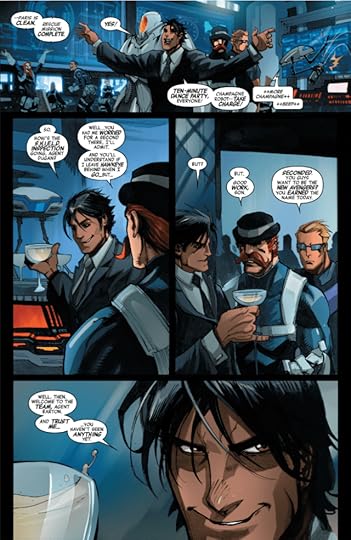
While S.H.I.E.L.D. and A.I.M. are big players in this series, a new acronym plays a major role: W.H.I.S.P.E.R. The World Headquarters for International Scientific/Philosophical Experimentation and Research is the brain child of The Maker, the evil Reed Richards from the now deceased Ultimate universe.
The Maker is a great villain, just crazy enough to be entertaining without being dark. He’s a big science bad guy and, on paper, he is much smarter than anyone on the New Avengers, which makes him an excellent big bad.
As usual, Ewing spends much of the series digging into his cast’s histories. The last volume of Young Avengers had introduced the idea that Wiccan would eventually become The Demiurge, a super powerful god. Ewing not only brings this to fruition, but introduces that stories logical end, then brings heroes from the future back in time to try to stop Wiccan.
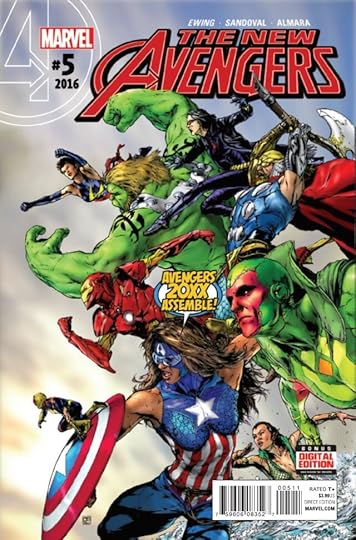
That story arc introduces us to the Captain America of the future (noted as 20xx so as to keep it in line with Marvels’ sliding time line), Danielle Cage, the daughter of Luke Cage and Jessica Jones. We’ll see her again later in Ewing’s Avengers run.
White Tiger’s past comes back to haunt her, too, as the previous White Tiger, once resurrected by the Hand, is freed and given her own White Tiger amulet by The Maker. Given that our White Tiger recently changed the rules of her relationship with the Tiger God, things don’t go well when she faces her aunt.
As is the case with Ewing’s Avengers books, New Avengers becomes mired in crossovers. The first is Avengers: Standoff which, as far as crossovers go, is pretty awful. But it gives Ewing a chance to place the team in a bit of a moral quandary that divides them up. It also gives Bobby another opportunity to prove that he’s always one step ahead.
Speaking of which, The Maker spends the series plotting against Sunspot and his team, while a faction of S.H.I.E.L.D. is also making moves against the New Avengers. Those two stories come together in one very satisfying and entertaining climax, although the results alter the standing of the new A.I.M.
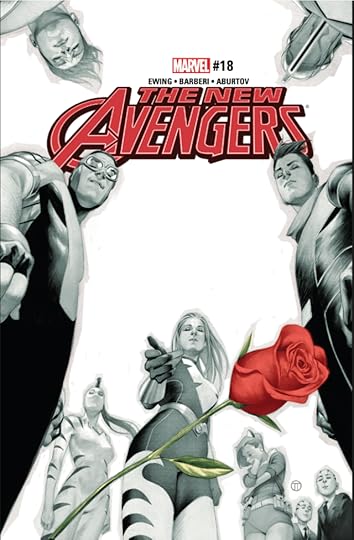
So at the end of the series, Bobby makes a deal with the U.S. government which rolls us into the next Ewing-verse series, U.S. Avengers.
For what it’s worth, New Avengers lasts 18 issues, so it’s the longest run of any of the Ewing Avengers books.
Make Avengers Bizarre AgainU.S. Avengers is a weird book. The line-up is strange. Sunspot now calls himself Citizen V (which is cool) and brings along his best friend Cannonball, Enigma (formerly Pod, which is a long story), Iron Patriot (also a long story), a new Red Hulk, and Squirrel Girl. The team also briefly features the aforementioned Captain America from the future, Danielle Cage, and Smasher, last seen on Hickman’s expanded Avengers team.
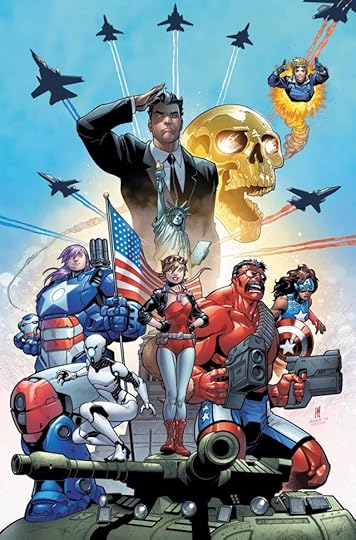 The stories are strange, too, in that they seem disjointed, not at all like what we saw in New Avengers which had a very clear through line. This series seems broken up into parts, from a rollicking adventure with time travelers, to big monster fights, to yet another crossover, to a strange alien adventure with the cast of Archie.
The stories are strange, too, in that they seem disjointed, not at all like what we saw in New Avengers which had a very clear through line. This series seems broken up into parts, from a rollicking adventure with time travelers, to big monster fights, to yet another crossover, to a strange alien adventure with the cast of Archie.
I might be overstating to say there’s no through line; it’s more like the through line doesn’t carry as much weight as we’ve seen before. U.S. Avengers starts coming out after Trump was elected and it’s easy to see that this comic regularly attempts to deal with various parts of America.
The initial villain is The Golden Skull. Look at these pages from the end of the first issue:
That’s a pretty clear indictment of America as it currently exists. The U.S. military would get similar treatment, as would America’s fascination with its own, fictional history. The “Secret Empire” crossover actually works thematically, although the fact that it’s such an awful event undermines it.
The problem is that none of it is particularly new and while the ideas are decent, it never seems like Ewing’s heart is in this book. It seems like he enjoys digging into characters and coming up with crazy big ideas, both of which are hampered by what comes off as an inorganic attempt at making a statement.
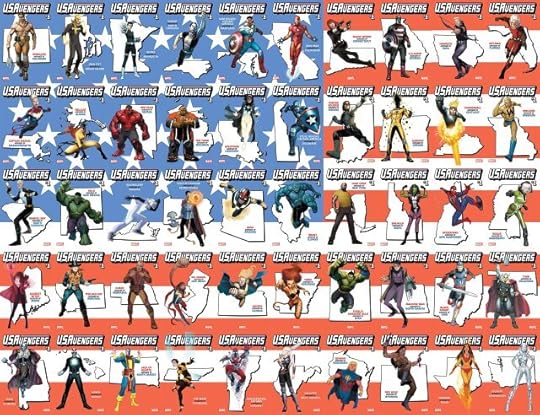 Still, Ewing has fun with the cast when he can and any book that features a good amount of screen time for Sunspot and Cannonball is always welcome.
Still, Ewing has fun with the cast when he can and any book that features a good amount of screen time for Sunspot and Cannonball is always welcome.
The series lasts 12 issues, 5 of which are pulled into Secret Empire, which continues an unbelievable streak of Ewing’s comics. The fact that he has to navigate so many crossovers from series to series is kind of unreal.
U.S. Avengers ends with a note telling us the team will be seen in the big upcoming Avengers “No Surrender” story.
The post The Ewingverse Avengers, Part 2: The A Stands for Al appeared first on KyleGarret.com.



